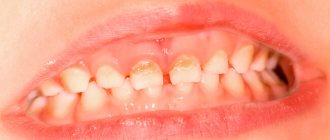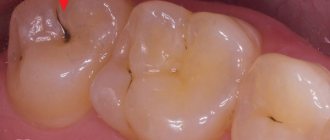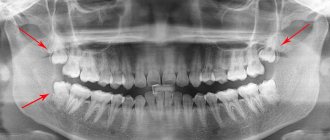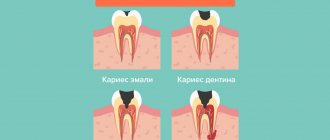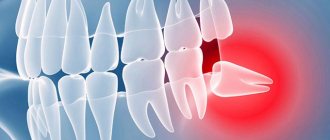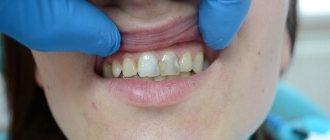Stages of caries
Everything related to this disease - symptoms, treatment methods, etc. – depends on the degree and stage of caries.
There are four stages of the disease:
- Spot. In this case, only the pigmentation of the enamel changes, that is, a dot or speck appears on its surface.
- Surface. At this stage, the doctor diagnoses damage to the shiny enamel layer of the tooth.
- Median. With this disease, pathogenic microbes eat away the hard tissues inside the crown of the tooth - dentin.
- Deep. This is the most dangerous type of caries, in which the degree of damage is so global that there is practically no partition left between the carious lesion and the chamber in which the pulp is located.
Tooth root caries: is it possible to treat and save the tooth?
Tooth root caries most often has to be treated in an advanced stage, since the gums prevent you from seeing the carious damage in this area. Therefore, patients come to the doctor only when the tooth begins to hurt.
Is it possible to treat and save a tooth with tooth root caries? The answer to this question will depend on how much the disease has damaged the tooth root. If the damage is significant, treatment will be carried out either by surgical methods, or the dentist will recommend that you remove the tooth and later restore it with prosthetics or implantation.
Symptoms of caries
- At the initial stage, caries manifests itself only externally. If the tooth is frontal, the patient himself may notice a black dot or a small dark spot. If the lesion begins to develop on the chewing teeth or on the lingual side of the row, only regular visits to the dentist will help to recognize the disease at an early stage.
- Median caries begins to make itself felt with discomfort while eating or drinking. An unpleasant, aching or painful reaction develops to sour, sweet, hot or cold.
- Patients who ignore going to the dentist and visit him extremely rarely may find a hole in the tooth cavity with their tongue. This means that caries has been eating away hard tissue for a long time and is already preparing to descend to the nerve.
Prevention of caries
- Brush and floss your teeth twice a day.
- A child can be taught oral hygiene from the age of two. Special children's pastes are used, for example "Buratino", "Nutcracker", which have a pleasant taste for the child.
- Use pastes with a high content of fluorine and calcium.
- Visit your dentist twice a year and have a professional cleaning done.
Only timely contact with a specialist and effective intervention by a professional will help avoid progression of the disease in children and adults.
Causes of caries
- Bacterial
It is bacteria that can produce acids, destroying fluoride and calcium in the enamel and dentin. Already 2 hours after you brush your teeth, they begin to appear on the surface again, gather in colonies, form plaque, then tartar.
- Physiological
Some people produce little saliva. They are potential candidates for permanent dental problems. The more saliva in the mouth, the more the negative effects of bacteria are neutralized. Accordingly, if your mouth is dry, it is easier for caries to develop in it.
- Poor nutrition
Yes, sweets are bad for your teeth! Moreover, eating a huge piece of cake and then brushing your teeth is more beneficial for your teeth than eating one small candy at night and forgetting about hygiene. The fact is that the harmful effects of glucose on teeth depend not on the amount of sugar, but on how long the sweets are in contact with the tooth enamel in the mouth.
- Special conditions of the body
A pregnant woman can develop caries due to the fact that a certain part of the mineral substances from her skeletal system is spent on the development of the baby's fetus. The connection between stressful conditions and the development of caries has also been proven.
What is fluoride varnish and how does it work?
The composition of fluoride varnish includes:
- shellac,
- sodium fluoride,
- fir or cedar balsam,
- chloroform,
- ethanol.
It is a viscous dark brown composition with a pine smell. Coating teeth with fluoride varnish creates a protective film that remains on the enamel for a long time. In doing so, it operates as follows:
- affects microorganisms on the surface of the tooth, preventing them from absorbing glucose and releasing acid that destroys enamel;
- interacts with the enamel, forming a hard layer that serves as a kind of shield for the teeth;
- absorbs calcium contained in saliva, restoring the mineral structure of the enamel, saturating it with necessary elements;
- has a positive effect on the gums, making them more elastic and stronger.
Thus, the use of fluoride varnish allows you to avoid many diseases associated with teeth, including caries and periodontitis. Applying varnish increases the service life of fillings and also reduces tooth sensitivity.
Treatment of caries
The principles and methods will vary depending on what stage of caries we are talking about. If this is a point or spot on the surface of the enamel, then the doctor will be able to do without preparation or drilling of hard tissue. Special compounds are used to apply to the stain, which saturate the affected area with minerals.
If mineralization is carried out efficiently and on time, the disease will recede and caries will not develop further. However, in most cases, patients come to the clinic when the stage of superficial caries is far behind. If enamel and dentin tissues are affected, the area softened by bacteria must be removed. For this purpose, modern drills are used, which, thanks to water-air support for drilling, ensure an almost completely painless procedure
The treatment algorithm for hard tissue preparation is as follows:
- Tooth isolation using a rubber dam
- Administration of anesthesia
- Preparation of tissue softened by bacteria
- Treatment of the exposed cavity with medicinal compounds
- Installing a seal
- Grinding and polishing of the filling to achieve an ideal external result
You can make an appointment with a therapist at the ILATAN clinic at any time. We treat teeth using modern and classical techniques, using high-tech equipment. In particular, the use of a microscope has proven itself to be excellent - cavity preparation occurs as accurately as possible, without the risk of removing excess healthy tissue. Call, sign up using the form on our website, come! We will ensure the health of your teeth!
Fluoridation: strengthening and protecting teeth
Since childhood, we have all been told that we need to eat less sweets and more fresh fruits, vegetables and dairy products. And why all? They contain useful vitamins and minerals that support the health of the body, give energy and strength. Our teeth also need additional nutrition. When teeth are strong from the inside, they are better able to withstand external influences, which means that the risk of caries is reduced significantly. How to strengthen and restore tooth enamel? What is fluoridation and why is fluoride varnish needed?
Treatment of caries in adults at various stages:
- superficial. The initial stage of this disease is characterized by a small zone of carious cavity and small areas of demineralization. In such cases, medicinal preparations based on phosphorus, calcium and fluorine are used. They are applied to the tooth surface for additional protection. The infected cavity is sealed after treatment;
- average. In this case, local damage to dental tissues already occurs. They may also experience periodic pain. In such situations, the affected tissues are cleaned and subsequently filled. If necessary, local anesthesia is used;
- deep. At this stage, extensive damage to the dental tissue occurs, sometimes the nerve is affected (acute pain, festering areas, swelling of the gums occur). Treatment of caries in such cases is more thorough and longer. It consists of therapeutic procedures in the dental canals, cleansing the diseased cavity, filling and subsequent restoration of the tooth shape.
How is dental caries treated?
30.04.2020
The most common dental disease is caries. Its timely diagnosis and treatment are very important to prevent more serious diseases that it can lead to. Therefore, caries occupies special attention.
Dental caries is a cavity (cavity) that has formed in the tooth as a result of damage to the enamel. Damage to enamel can be either traumatic or chemical. Traumatic damage is a chip of enamel as a result of injury, which leads to a disruption of the natural protective barrier and microorganisms penetrate into the softer and unprotected layers of dentin, which leads to its further destruction. Chemical damage to tooth enamel is damage by waste products of microorganisms (mainly acids), which are present in the oral cavity in huge quantities. A special breeding ground for microbes is created by consuming large amounts of sweets and other carbohydrates, as well as poor hygiene.
Diagnosis of caries
does not cause problems, but requires special attention and equipment.
The basis of diagnosis is a thorough instrumental examination. This is a painless procedure that reveals the presence of the carious cavity itself and the tooth’s reaction to irritants: cold, warm, sour, sweet. The nature of the tooth’s reaction can provide a preliminary indication of the stage of the disease. Additional methods for diagnosing dental caries are x-rays
and
laser diagnostics of hidden caries.
The use of all these methods in combination provides high accuracy in diagnosing caries.
How is dental caries treated? There is a common belief that this is just a “hole in the tooth” and it is enough to “fill it up with something.” Phrases in quotation marks are the most common statements made by patients. Also, many believe that he had a small hole, and the doctor drilled out half of the tooth. Indeed, tooth enamel is the strongest tissue in the body, and the carious process only needs to make a small hole in it and switch to softer dentin, which is more susceptible to destruction. So it turns out that in order to clean out all the dentin affected by caries, it is necessary to remove all the overhanging edges of the enamel and from a small hole we get a more extensive cavity. But this only happens when a person does not dare to see a doctor for a long time, because, in his opinion, he only has a small hole, and the carious process is already in full swing in the dentin. Therefore, we recommend undergoing a professional examination every six months in order to identify carious teeth in a timely manner.
There is essentially one way to treat caries. This is to thoroughly clean all tooth tissue affected by caries (carious enamel and dentin), and then restore the tooth and give it its original appearance using various materials ( heliocomposites
,
ceramic or composite inlays
). Treatment of caries of the anterior teeth also requires highly aesthetic work by the doctor, as well as the use of special materials intended for the restoration of the anterior teeth.
Stages of caries treatment. First of all, a thorough diagnosis. Then anesthesia, which is practically painless, because... Modern thin needles with a diameter of 0.3 mm are used, as well as modern anesthetics. After complete anesthesia, the doctor removes all carious dentin to healthy tooth tissue. The tooth is treated with an antiseptic and an adhesive base for future restoration with a filling ( heliocomposite
). The composite material is applied layer by layer into the tooth cavity, its anatomy is restored and illuminated with a special lamp. Next, the filling is ground to the bite and polished. Not everything depends on the quality of the material, but also on the hands of the doctor, who must carefully remove all damaged dentin so that caries does not develop again under the filling.
Treatment of caries in adults and children is practically no different. Only in baby teeth is caries fleeting and the process soon spreads to the nerve, which leads to its inflammation. Therefore, it is very important to monitor your children’s teeth and regularly bring them for professional examinations in order to receive treatment on time.
But the most important thing in the treatment of caries is its prevention. Although it cannot be fully called treatment, it is a very important condition for the absence of caries on the teeth. Remember to brush your teeth thoroughly twice a day after meals, use dental floss between your teeth, and reduce the amount of sweets, especially for children. If you eat candy, brush your teeth if possible or simply rinse your mouth thoroughly with plain water. Get professional oral hygiene from a doctor. And visit the dentist at least once every six months.
